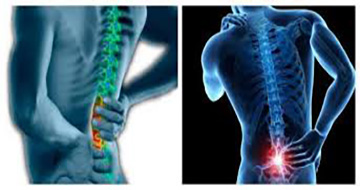Spondylolisthesis is a common spine pathology in which one vertebral body slips out of its normal position over the other vertebrae. There is malalignment of spine leading to deformity of spine then narrowing of spinal canal producing symptoms
Slippage may be forward (anterolisthesis) or backward (retrolisthesis)
Spondylolisthesis is seen in both children and adults with varied presentation and severity
Spondylolisthesis is most often caused by spondylolysis (Fracture of bony structure called the pars interarticularis, which connects the facet joints of the spine)
There are different types of spondylolisthesis and grading system (depending upon degree of slippage)
Grading is based amount of slippage (Mayerding classification)
Grade 1: 25 % of the vertebral body has slipped forward
Grade 2:25-50 % of the vertebral body has slipped forward
Grade 3: 50-75 % of the vertebral body has slipped forward
Grade 4: 75-100 % of the vertebral body has slipped forward
When one vertebra slips entirely off the one below (>100%), this is known as spondyloptosis
Common Facts:
- Spondylolisthesis most commonly occurs in the lower lumbar spine but rare in the cervical spine and thoracic spine expect for trauma
- Degenerative spondylolisthesis – commonest form seen in adults
- Isthmic spondylolisthesis – common in adolescent and young adults
- Dysplastic spondylolisthesis – more common in the pediatric population (females > males)
- Grade I spondylolisthesis accounts for 75% of all cases
- Spondylolisthesis most commonly occurs at the L5-S1 level
- Severity of symptoms is based degree of slippage
Risk factors:
- Sports – especially gymnasts, weightlifting, football and baseball players
- History of frequent repetitive overstretching (hyperextension)
- Female population
- Overweight and Obesity
- Spine trauma
Causes:
- Congenital spondylolisthesis referred as dysplastic spondylolisthesis is abnormality since birth and there is defect in the formation of part of the vertebra called the facet that allows it to slip forward
- Isthmic spondylolisthesis is defects in the pars interarticularis – possibility due repetitive trauma – fatigue fracture of pars
- Degenerative spondylolisthesis – results due degenerative changes in spine as part of aging process
- Traumatic spondylolisthesis – fractures of the pars interarticularis or the facet joint of spine following high velocity trauma
- Pathologic spondylolisthesis – defect in the bone due to infection, neoplasm, post-surgery in lumbar spine
Symptoms:
- Back pain – commonest symptom – typically worse with prolonged standing, bending and lifting and often relieves on lying down or sitting
- Pain in the back while getting up from sitting position
- Pain, numbness and weakness in legs (Sciatica) – as the spine becomes unstable and put pressure on nerves (stenosis)
- Neurogenic claudication – buttock and leg pain and cramps caused by walking for short distance, but pain subsides on rest
- Loss of bowel and bladder function in cases of severe nerve compression
Diagnosis can be made based on symptoms and imaging (MRI and CT) shows degree of slippage, as well as severity of narrowing or compression nerves in spinal canal.
The CT and MRI is usually performed when patient lying flat, however in certain situations slippage is seen obviously when standing or bending forwards, so your neurosurgeon surgeon will sometimes get flexion, extension and standing X-rays
Treatment:
- Modifying your activity – Restriction of your routine physical activities, this will help to help settle symptoms (avoid sudden repetitive bending)
- Physiotherapy – When symptoms are not severe – rehabilitation program will help in reducing pain and inflammation, as well as improving mobility, strengthening spinal musculature and correcting your body posture to reduce back pain
- Medication – important role in easing pain and muscle spasms
- No role of traction
- Lumbar belt / corset – short term relief – harmful when used for prolonged time
Indications for surgery in patients who have spondylolisthesis:
- Grade 2 and above slippage
- Progressive spondylolisthesis – Slippage that is progressively worsening
- Leg pain at rest
- Back pain that has not improved after a period of nonsurgical treatment
- Significant reduction of quality of life
Surgical options:
1. Decompression – When spine is stable and in stable grade I listhesis
Goal – relieve compression on nerve
Performed by removing a small amount of bone and disc to open the space for the nerves within the spinal canal
2. Spinal fusion – Progressive slippage and grade 2 and more
Goal – Prevent further progression of slippage, stabiles the spine and relieve symptoms
Can be performed from back (TLIF), side (XLIF, OLIF) and from front (ALIF)
The necessity of spinal fusion as fusion eliminates motion between vertebrae and makes spine stable. The fusion is performed screws, rods and cages to stabilize the vertebral bodies. Cages are filled with bone graft for fusion
Both surgeries are performed under general anesthesia in minimal invasive fashion, Decompression requires a 2 cms incision in the back, whereas fusion require multiple small incision.
What can I expect after surgery?
Most patients are usually in the hospital 1-3 days in the hospital. Patients are usually up and walking the day after surgery. Return to activities is based patients general condition, wound healing and surgeon’s recommendations.




